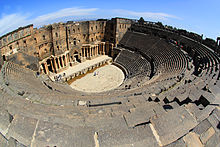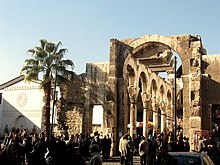
Syria
Syria briefly came under Armenian control from 83 BC, with the conquests of the Armenian king Tigranes the Great, who was welcomed as a savior from the Seleucids and Romans by the Syrian people. However, Pompey the Great, a general of the Roman Empire, rode to Syria and captured Antioch, its capital, and turned Syria into a Roman province in 64 BC, thus ending Armenian control over the region which had lasted two decades. Syria prospered under Roman rule, being strategically located on the silk road, which gave it massive wealth and importance, making it the battleground for the rivaling Romans and Persians.

Palmyra, a rich and sometimes powerful native Aramaic-speaking kingdom arose in northern Syria in the 2nd century; the Palmyrene established a trade network that made the city one of the richest in the Roman empire. Eventually, in the late 3rd century AD, the Palmyrene king Odaenathus defeated the Persian emperor Shapur I and controlled the entirety of the Roman East while his successor and widow Zenobia established the Palmyrene Empire, which briefly conquered Egypt, Syria, Palestine, much of Asia Minor, Judah and Lebanon, before being finally brought under Roman control in 273 AD.
The northern Mesopotamian Assyrian kingdom of Adiabene controlled areas of north east Syria between 10 AD and 117 AD, before it was conquered by Rome.
The Aramaic language has been found as far afield as Hadrian’s Wall in Ancient Britain, with an inscription written by a Palmyrene emigrant at the site of Fort Arbeia.
Control of Syria eventually passed from the Romans to the Byzantines, with the split in the Roman Empire.
The largely Aramaic-speaking population of Syria during the heyday of the Byzantine Empire was probably not exceeded again until the 19th century. Prior to the Arab Islamic Conquest in the 7th century AD, the bulk of the population were Arameans, but Syria was also home to Greek and Roman ruling classes, Assyrians still dwelt in the north east, Phoenicians along the coasts, and Jewish and Armenian communities were also extant in major cities, with Nabateans and pre-Islamic Arabs such as the Lakhmids and Ghassanids dwelling in the deserts of southern Syria. Syriac Christianity had taken hold as the major religion, although others still followed Judaism, Mithraism, Manicheanism, Greco-Roman Religion, Canaanite Religion and Mesopotamian Religion. Syria’s large and prosperous population made Syria one of the most important of the Roman and Byzantine provinces, particularly during the 2nd and 3rd centuries (AD).

Syria is significant in the history of Christianity; Saulus of Tarsus, better known as the Apostle Paul, was converted on the Road to Damascus and emerged as a significant figure in the Christian Church at Antioch in ancient Syria, from which he left on many of his missionary journeys. (Acts 9:1–43)
